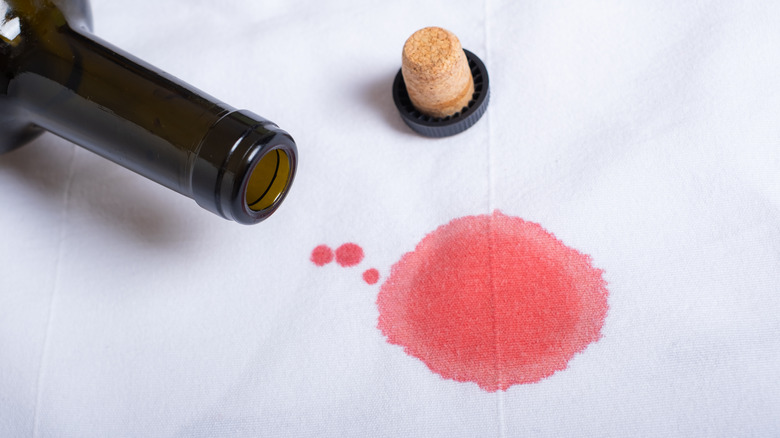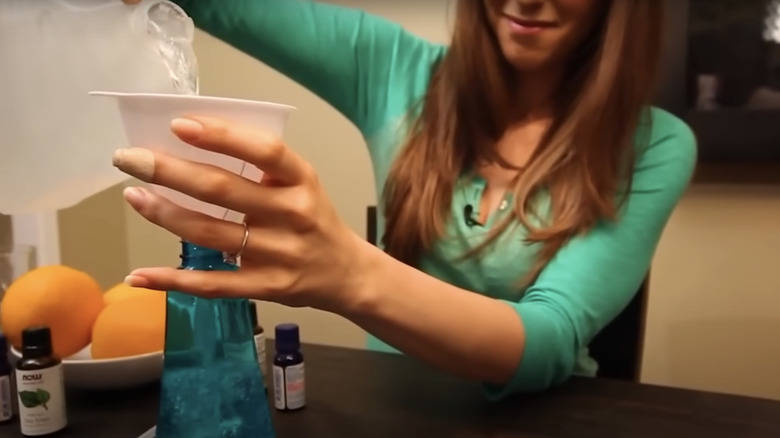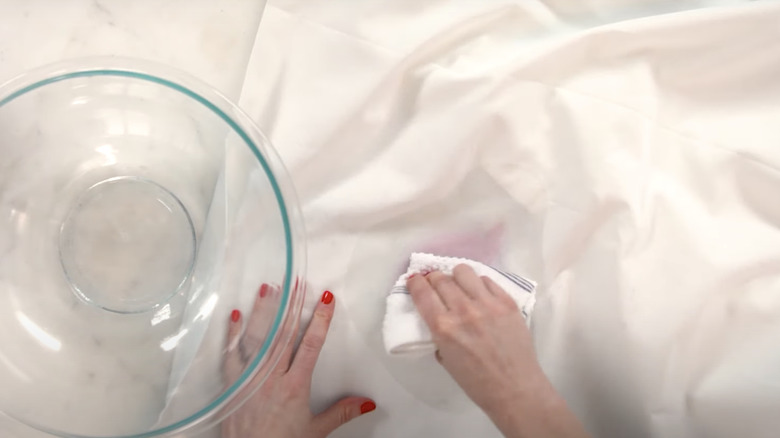The Common Ingredient That'll Lift Wine Stains From Your Favorite Tablecloth
We may receive a commission on purchases made from links.
Hosting dinner parties is all fun and games until someone spills white or red wine all over your favorite tablecloth. Even though accidents are inevitable, it still stings a little when you see the wine start to seep into the cloth. The best thing to do is clean it as soon as you see it to prevent the stain from sitting for too long. If it's left for too many hours, overnight, or a few days, the stain can be more challenging to eliminate. We all know red wine is already tricky to get out of fabrics, so the faster you clean it up, the better results you'll get. However, if you happen to notice the stain the following day, you can still save your tablecloth by soaking it in white vinegar and water. You might add a few drops of laundry detergent to create a stronger solution, but white vinegar can work perfectly on its own.
Vinegar is a versatile cleaning tool and a common ingredient many homeowners already have at home. It's an acid, so it adds a chemical charge when applied to a stain. Further, when vinegar is mixed with water, positive and negative charges attract molecules in the stains, working against each other like magnets. They'll pull away from the fabric, allowing you to effortlessly remove the stain with more water. If you have a tablecloth that desperately needs a wine stain removed, grab white vinegar, water, and a spray bottle.
How to use white vinegar to eliminate wine stains from your tablecloth
White vinegar is extremely affordable, so if you don't have some at home, you can buy a large bottle at your local grocery store for less than $3. Target has a 64-ounce bottle for $2.99, while Walmart has a 64-ounce bottle for $2.74. It's best to use white vinegar because it neutralizes the red tones in red wine, making it effective for lifting wine stains. Once you gather your materials, mix equal parts white vinegar and water in a spray bottle. You can swap the bottle for a bowl if you don't have one. Then, spray the solution directly on the stain until it's soaked, and let it sit for half an hour. After soaking, rinse the cloth in cold water and repeat if necessary.
If the stain has been left overnight or is more stubborn, soak the tablecloth in the solution overnight, then wash it in cold water with laundry detergent to give an extra cleaning boost. However, you can add a few drops of your laundry detergent or dish soap to the solution before applying it to the tablecloth so that they work together simultaneously. In addition, carefully massaging the tablecloth while it's soaking will help disperse the solution better into the fibers.
Things to avoid when removing wine stains from your tablecloth
The most common tablecloths homeowners purchase are linen styles, which are much easier to freshen up than satin, silk, wool, or other materials. White vinegar should help remove red wine stains if you own tablecloths in any fabric. As always, it's best to avoid letting the stain sit for too long. Avoid applying heat to dry the stain when it first gets wet because it will cause the stain to become permanent and more complicated to remove. Once it gets wet, dab any excess wine to prevent it from spreading and creating a more prominent stain. Then, soak it in the white vinegar solution. Never scrub the spill with a towel or underwater because it causes the wine to spread or move deeper into the fibers.
Some folks will tell you that pouring a little white wine on a red wine stain will neutralize and remove the red stain because it's a lighter color. However, this is a myth, and will only make removing the red wine stain more difficult. It won't clear the stain; instead, it'll help spread it further around the tablecloth. White wine isn't any kind of cleaning solution. It doesn't have chemical properties that will help lift stains, so avoid applying it to any red wine stain or stains in general. The only time you can get away with using white wine to clean something is if you have to cut through grease stains on your concrete floor.


